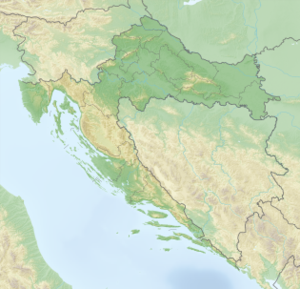Dvigrad
| Dvigrad | ||
|---|---|---|
|
Dvigrad |
||
| Creation time : | 879 | |
| Conservation status: | ruin | |
| Standing position : | Nobles | |
| Place: | Dvigrad | |
| Geographical location | 45 ° 7 '37.2 " N , 13 ° 48' 42.4" E | |
|
|
||
Dvigrad is an abandoned ruined city in the municipality of Kanfanar in the Croatian part of the Istrian peninsula .
The medieval town is located in the Draga Valley. It stands on the remains of a prehistoric settlement and has been abandoned since 1631. In the Middle Ages, Dvigrad was an important trading center in the region due to its strategic location. The site is considered an outstanding example of a symbiosis of sacred and secular buildings, castle and early urban settlement. Since the early Middle Ages, originally two castles (Latin: Duo Castra = Croatian. Dvigrad ) have developed into a fortress-like settlement with around 1,000 inhabitants, which was never destroyed but only abandoned at the end of the 17th century.
history
The Illyrians settled the Dvigrad area in ancient times. The Croatians came in the 7th century. It was first mentioned in a document in 879. Later the Carolingians and Ottonians exercised rulership rights here, but also increasingly the Counts of Gorizia and, since the late Middle Ages, the naval power of Venice. In 1345 the village was sacked by the Genoese admiral Paganin Doria during the war between Genoa and Venice. The Venetians, for their part, plundered the place in 1383. It was not until 1413 that a nobleman from Koper was appointed governor by the Venetians. In the 16th century, epidemics such as the plague and malaria struck Dvigrad. In 1631 almost all of the inhabitants left the village or died. Only three families remained around 1650; the place was deserted by 1714 at the latest. The buildings then fell into disrepair, leaving ruins. The former castle is best preserved.
Currently (as of 2017) the ruined village is a tourist destination. Protective measures and restorations are pending. The area has only recently attracted the interest of historians and archaeologists. In 1997 the Croatian authorities declared the facility in Dvigrad a cultural heritage and slowly began to renovate and restore it. In the years 2001 to 2005 extensive excavations took place, which uncovered far-reaching knowledge about the way of life of the medieval people, the age and the functioning of the remaining buildings and fortifications. The overall area appears rather untypical for old castles and is considered a unique testimony to a medieval fortification with an early settlement. Dvigrad was included in the list of projects for the restoration of the common cultural heritage in Southeast Europe. Research and conservation work on the ruins is currently ongoing.
literature
- Stefan Hirschmann: Dvigrad in Istria - an abandoned settlement from the Middle Ages . In: Castles and Palaces. Journal for Castle Research and Monument Preservation, Vol. 1 . 2017, p. 4-16 . ( Digitized version )
- Sandro Jurman: Guide to Kanfanar . Ed .: Tourist Community of Kanfanar Municipality. 2018, p. 15-20 .

